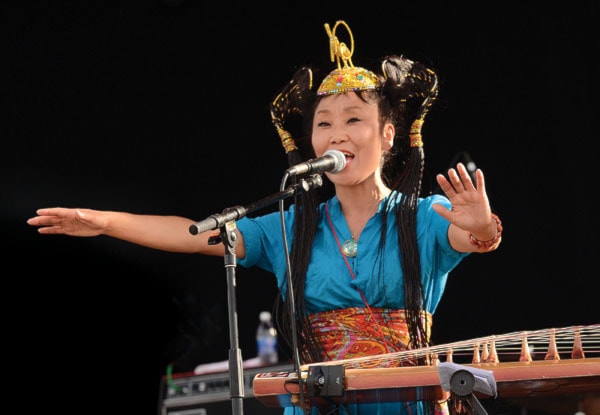While Russian-speaking Namgar Lhasaranova might seem a little tentative onstage as she struggles to read a short opening greeting in English, there’s no mistaking her ability to communicate once she opens her mouth to sing.
Her power, energy and amazing vocal range go beyond words and language, taking her audience on a journey to Siberia and the world of the Buryats, people whose roots reach back to Ghengis Khan and the Mongolian Empire.
She is the core of the group Namgar, one of the most unique ensembles at the Salmon Arm Roots and Blues Festival. Although the group is currently based in Moscow, Namgar herself was born in a small village on the steppe near the border of China, Mongolia and Russia.
She and her husband Eugeny Zolotarev, who plays both lead guitar and chanza – a banjo-like lute, are inspired by a drive to preserve the Buryat history and culture.
What’s now Buryatia was colonized by Russians in the 17th century.
Through Sergei Sokuler, the group’s bass guitarist and best English-speaker, Namgar explains: “The modern arrangement is, first of all, not for European public but for Buryatian youth – because most young people who are 19 and 20 and live in towns in Buryatia don’t speak the Buryatian language.”
However, she says, there is something of a revival taking place.
“Nowadays young people are more interested in their heritage in Buryatia – there’s a festival called Voice of Nomad, many young people go. The youth are getting more interested in the history of the Buryats.”
Sokuler and drummer Viktor Konkov are both professional musicians, and Namgar is just one of several bands they play with.
“It’s our job. If you want to earn a living making music, you have to not play in only one band,” Sokuler explains. “It’s quite exciting, we’re not interested in just one style, and you become a more universal musician.”
Although the bass player and drummer have no Buryat roots, Namgar says they understand the music.
“Her husband is Russian... and we are Russians too,” says Sokuler. “We have been playing with them since March... In Moscow there are lots of musicians but it’s very hard to find musicians who feel the Asian ethnic music.”
Dressed in a beautiful turquoise dress with a wide red sash, Namgar wears a traditional headdress featuring long ponytails and, on top, jewels and a golden deer with curling horns – the same type of headdress women in Mongolia and Buryatia wear, the same she wore when she was married.
She plays both the yatga, a stringed instrument with a long wooden body, and a khomus or jaw harp.
Sokuler explains that Namgar and her husband began playing traditional Mongolian and Buryatian folk songs together in the 1980s, and “this project with more arrangements started about two years ago.”
‘More arrangements’ includes what might be called a fusion of Russian rock and traditional folk songs, pounding rhythms with haunting melodies.
Namgar likes Canada, having visited four times. Last year it was six festivals during a two-month tour; this year, seven festivals in 36 days.
